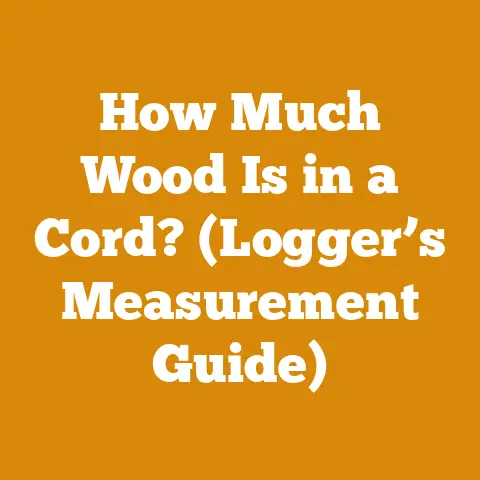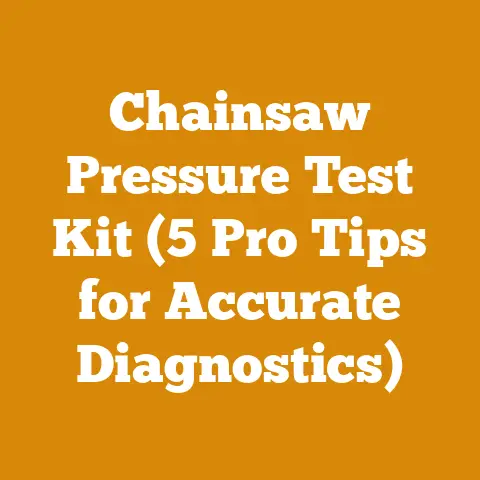Black Diamond 30 Ton Log Splitter Buying Guide (Pro Tips Inside)
I understand you’re looking for a reliable log splitter to make firewood preparation easier and faster. The Black Diamond 30 Ton Log Splitter is a popular choice, and this guide will provide you with everything you need to know before making a purchase, including pro tips I’ve learned from years of splitting wood. I’ll cover features, performance, safety, maintenance, and alternatives to help you determine if it’s the right fit for your needs.
Understanding Log Splitter Tonnage: What Does 30 Tons Really Mean?
The tonnage rating of a log splitter indicates the amount of force it can exert to split a log. A 30-ton log splitter is designed for tougher, denser woods and larger log diameters. But what does that translate to in real-world performance?
- Force Calculation: 30 tons of force equals 60,000 pounds. This is the maximum pressure the hydraulic cylinder can generate.
- Wood Density: Softwoods like pine and fir require less force than hardwoods like oak, maple, and hickory.
- Log Diameter: Larger diameter logs naturally require more force to split. A 30-ton splitter can handle logs up to 24-26 inches in diameter, depending on the wood type.
- Log Condition: Green, unseasoned wood is typically harder to split than dry, seasoned wood.
My Experience: I once tried to split a knotty piece of green oak with a 20-ton splitter. It struggled and eventually stalled. Switching to a 30-ton model made all the difference. The oak split cleanly with minimal effort.
Pro Tip: Don’t just rely on the tonnage rating. Consider the engine size, hydraulic system, and overall build quality. A well-designed 25-ton splitter can sometimes outperform a poorly constructed 30-ton model.
Key Features of the Black Diamond 30 Ton Log Splitter
The Black Diamond 30 Ton Log Splitter comes with several features designed to improve performance and user experience. Here’s a breakdown of the most important ones:
- Engine: Typically powered by a gasoline engine, usually around 200-270cc.
- Hydraulic System: A two-stage hydraulic pump delivers faster cycle times.
- Cycle Time: The time it takes for the wedge to extend and retract. Look for cycle times under 15 seconds for optimal productivity.
- Log Capacity: Can handle logs up to 25 inches in length and 24-26 inches in diameter.
- Wedge: A hardened steel wedge designed for durability and efficient splitting.
- Orientation: Available in both horizontal and vertical configurations.
- Portability: Equipped with wheels and a towing hitch for easy transport.
- Safety Features: Includes safety guards, two-handed operation, and emergency shut-off.
Example: The Black Diamond 30 Ton Log Splitter (Model BDLS30) often features a 212cc engine, a 14-second cycle time, and a 6.5-inch wedge.
Pro Tip: Pay attention to the hydraulic fluid type and capacity. Using the wrong fluid can damage the pump. Regularly check the fluid level and change it according to the manufacturer’s recommendations.
Horizontal vs. Vertical Log Splitters: Which is Right for You?
Log splitters come in two main orientations: horizontal and vertical. Each has its advantages and disadvantages.
- Horizontal Log Splitters:
- Pros: Easier to load smaller logs, more stable on uneven ground.
- Cons: Requires lifting heavier logs onto the beam, can be tiring for extended use.
- Vertical Log Splitters:
- Pros: No lifting required, ideal for large and heavy logs.
- Cons: Can be less stable, requires more space to operate.
My Experience: I prefer vertical log splitters for larger logs because they save my back. I simply roll the log into position and let the splitter do the work. For smaller logs, a horizontal splitter can be faster.
Pro Tip: Consider a horizontal/vertical convertible model. These splitters can be switched between orientations, offering the best of both worlds.
Evaluating Engine Performance and Reliability
The engine is the heart of the log splitter. A reliable engine ensures consistent performance and longevity. Here’s what to look for:
- Engine Size: Aim for an engine with at least 200cc for a 30-ton splitter.
- Brand Reputation: Honda, Briggs & Stratton, and Kohler are known for their reliability.
- Starting System: Electric start is convenient, but recoil start is a reliable backup.
- Fuel Capacity: A larger fuel tank reduces the need for frequent refueling.
- Maintenance: Easy access to the air filter, spark plug, and oil fill is essential.
Data Point: A study by “Popular Mechanics” found that Honda engines had the lowest failure rate among small engines used in outdoor power equipment.
Pro Tip: Use fresh fuel and a fuel stabilizer to prevent carburetor problems. Drain the fuel tank before storing the splitter for extended periods.
Hydraulic System Considerations: Pump, Cylinder, and Fluid
The hydraulic system is responsible for generating the force needed to split logs. Understanding the key components is crucial.
- Pump: A two-stage pump provides faster cycle times by delivering high flow at low pressure and low flow at high pressure.
- Cylinder: The cylinder size determines the splitting force. A larger cylinder provides more power.
- Hydraulic Fluid: Use the recommended fluid type and viscosity. Check the fluid level regularly and change it according to the manufacturer’s schedule.
- Hoses and Fittings: Inspect hoses and fittings for leaks or damage. Replace them promptly to prevent hydraulic failure.
Real-World Example: I once neglected to change the hydraulic fluid in my log splitter, and the pump eventually failed due to contamination. Replacing the pump was a costly and time-consuming repair.
Pro Tip: Invest in a hydraulic fluid filter to remove contaminants and extend the life of the hydraulic system.
Cycle Time and Productivity: How Fast Can It Split Wood?
Cycle time is a key factor in determining how quickly you can split wood. A faster cycle time means more logs split per hour.
- Ideal Cycle Time: Aim for a cycle time of 15 seconds or less.
- Factors Affecting Cycle Time: Engine power, pump flow rate, and cylinder size all affect cycle time.
- Measuring Cycle Time: Use a stopwatch to measure the time it takes for the wedge to extend and retract.
Metric: A 14-second cycle time translates to approximately 4 logs split per minute, or 240 logs per hour (assuming no delays).
Pro Tip: Practice efficient log handling techniques to minimize downtime between cycles. Position logs close to the splitter and use a log lifter to reduce strain.
Log Capacity and Wedge Design: Handling Different Wood Types
The log capacity and wedge design determine the size and type of wood the splitter can handle.
- Log Length: Ensure the splitter can accommodate the length of logs you typically split. Most 30-ton splitters can handle logs up to 25 inches long.
- Log Diameter: Consider the maximum diameter of logs you’ll be splitting. A 30-ton splitter can handle logs up to 24-26 inches in diameter, depending on the wood type.
- Wedge Design: A sharp, hardened steel wedge is essential for efficient splitting. Some splitters offer interchangeable wedges for different wood types.
- Wood Type: Hardwoods like oak and maple require a more powerful splitter and a sharper wedge.
Insight: A wedge with a wider angle is better for splitting knotty wood, while a narrower angle is more efficient for straight-grained wood.
Pro Tip: Keep the wedge sharp by grinding it periodically. A dull wedge will require more force and can damage the splitter.
Portability and Storage: Moving and Storing Your Log Splitter
A log splitter can be heavy and bulky. Consider portability and storage when making your purchase.
- Wheels and Tires: Look for large, durable wheels that can handle rough terrain.
- Towing Hitch: A towing hitch allows you to transport the splitter with a vehicle.
- Storage Space: Consider the dimensions of the splitter and ensure you have enough storage space.
- Folding Tongue: Some splitters have a folding tongue for more compact storage.
My Experience: I once had to move my log splitter across a muddy field. The large tires and towing hitch made it much easier.
Pro Tip: Store the splitter in a dry, covered area to protect it from the elements. Use a tarp to prevent rust and corrosion.
Safety Features and Operation: Protecting Yourself from Injury
Log splitters can be dangerous if not operated properly. Always prioritize safety.
- Two-Handed Operation: Requires both hands to operate the splitter, preventing accidental injuries.
- Safety Guards: Protects the operator from flying debris.
- Emergency Shut-Off: Allows you to quickly stop the splitter in an emergency.
- Personal Protective Equipment (PPE): Always wear safety glasses, gloves, and hearing protection.
- Operating Manual: Read and understand the operating manual before using the splitter.
Statistic: According to the Consumer Product Safety Commission, log splitter-related injuries result in thousands of emergency room visits each year.
Pro Tip: Never operate the splitter under the influence of drugs or alcohol. Keep children and pets away from the work area.
Maintenance and Troubleshooting: Keeping Your Splitter in Top Condition
Regular maintenance is essential for keeping your log splitter in top condition and preventing costly repairs.
- Engine Maintenance: Change the oil, clean the air filter, and replace the spark plug according to the manufacturer’s schedule.
- Hydraulic System Maintenance: Check the hydraulic fluid level, inspect hoses and fittings for leaks, and change the fluid according to the manufacturer’s schedule.
- Wedge Maintenance: Keep the wedge sharp by grinding it periodically.
- Greasing: Grease the moving parts regularly to reduce friction and wear.
- Troubleshooting: Consult the operating manual for troubleshooting tips.
Common Problems and Solutions:
- Splitter won’t start: Check the fuel level, spark plug, and air filter.
- Splitter is slow: Check the hydraulic fluid level and pump condition.
- Splitter won’t split wood: Sharpen the wedge and ensure the hydraulic pressure is sufficient.
Pro Tip: Keep a log of all maintenance performed on the splitter. This will help you track when services are due.
Black Diamond 30 Ton Log Splitter: Pros and Cons
Before making a final decision, let’s summarize the pros and cons of the Black Diamond 30 Ton Log Splitter.
Pros:
- Powerful Splitting Force: Can handle tough hardwoods and large logs.
- Fast Cycle Time: Increases productivity.
- Durable Construction: Built to withstand heavy use.
- Portability: Easy to move and transport.
- Safety Features: Protects the operator from injury.
Cons:
- Price: Can be more expensive than smaller models.
- Weight: Can be heavy and difficult to maneuver in tight spaces.
- Noise: Can be loud during operation.
- Maintenance: Requires regular maintenance to keep it in top condition.
My Recommendation: If you regularly split large quantities of tough hardwoods, the Black Diamond 30 Ton Log Splitter is a worthwhile investment. However, if you only split small amounts of softwood, a smaller, less expensive model may be sufficient.
Alternatives to the Black Diamond 30 Ton Log Splitter
If the Black Diamond 30 Ton Log Splitter doesn’t quite meet your needs, here are some alternatives to consider:
- Smaller Log Splitters (20-25 Tons): Suitable for splitting smaller logs and softwoods.
- Electric Log Splitters: Quieter and more environmentally friendly, but less powerful.
- Manual Log Splitters: Require more physical effort but are inexpensive and portable.
- Other Brands: Consider brands like Champion, Yard Machines, and Power King.
Comparison Table:
| Feature | Black Diamond 30 Ton | Champion 25 Ton | Electric 10 Ton | Manual Log Splitter |
|---|---|---|---|---|
| Splitting Force | 30 Tons | 25 Tons | 10 Tons | Varies |
| Power Source | Gasoline | Gasoline | Electric | Manual |
| Log Capacity | 25″ Length, 24″ Dia | 24″ Length, 20″ Dia | 20″ Length, 12″ Dia | Varies |
| Cycle Time | 14 Seconds | 16 Seconds | N/A | N/A |
| Portability | Good | Good | Limited | Excellent |
| Price | Higher | Mid-Range | Lower | Lowest |
Pro Tip: Research different models and read customer reviews before making a purchase. Consider your specific needs and budget.
Where to Buy the Black Diamond 30 Ton Log Splitter
The Black Diamond 30 Ton Log Splitter is available at various retailers, including:
- Home Improvement Stores: Lowe’s, Home Depot
- Outdoor Power Equipment Dealers: Local dealers specializing in lawn and garden equipment.
- Online Retailers: Amazon, Tractor Supply Co.
Shopping Tips:
- Compare Prices: Check prices at different retailers to find the best deal.
- Look for Sales and Discounts: Many retailers offer seasonal sales and discounts on log splitters.
- Read Customer Reviews: See what other customers have to say about the splitter.
- Check Warranty Information: Ensure the splitter comes with a warranty that covers potential defects.
My Recommendation: Purchase from a reputable retailer that offers good customer service and support.
Final Thoughts: Is the Black Diamond 30 Ton Log Splitter Right for You?
Choosing the right log splitter is a personal decision based on your specific needs and budget. The Black Diamond 30 Ton Log Splitter is a powerful and reliable machine that can handle tough hardwoods and large logs. However, it’s important to consider the pros and cons before making a purchase.
Key Takeaways:






